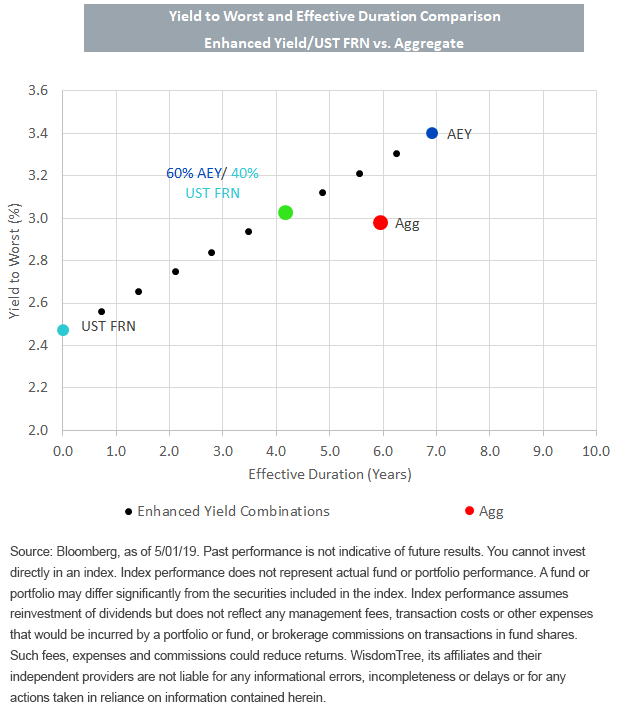“Barbell”ing Can Get the Job Done


Readers of our blog will probably be familiar by now with a fixed income strategy we advocate known as the “barbell.” We first broached the subject in mid-August of last year and revisited the approach in February. Now that we’ve entered the middle month of Q2, I thought it would be useful to provide a quarterly update. In the aftermath of another good employment report, we continue to conclude that “barbell”ing can help get the job done for fixed income investors.
As a reminder, the two “weights” in our barbell are the Bloomberg Barclays U.S. Aggregate Enhanced Yield Index (AEY) and the Bloomberg U.S. Treasury Floating Rate Bond Index (UST FRN). The latter index (UST FRN) serves as the short-duration weight of the barbell and is based on the 2-Year Treasury floating rate note. AEY is a yield-enhanced index that reweights the sectors of the Bloomberg Barclays U.S. Aggregate Bond Index (Agg) and serves as the longer-duration weight.

For definitions of terms in the chart, please click here.
The accompanying graph illustrates how an investor can implement various allocations between these two weights of the barbell in order to pursue the desired result and, in the case of our analysis, compare this result to the Agg. As the reader may recall, the focus about nine months ago was on a 70%-AEY/30%-UST FRN combination, but in February, we updated the pairing to a 60%-AEY/40%-UST FRN mix, and this blend remains in effect.
As of this writing, the 60%-AEY/40%-UST FRN blend offers a yield of 3.03%, or five basis points (bps) above the Agg, and it cuts the duration by 1.8 years versus the Agg. In terms of its component makeup, this barbell is over-weight government/government-related by 9% and over-weight investment-grade (IG) corporate bonds by 3% as compared to the Agg. Within the IG space, BBBs carry a modest 3% over-weight as well.
Conclusion
The WisdomTree Yield Enhanced U.S. Aggregate Bond Fund (AGGY), which seeks to track the Bloomberg Barclays U.S. Aggregate Enhanced Yield Index, and the WisdomTree Floating Rate Treasury Fund (USFR), which seeks to track the Bloomberg U.S. Treasury Floating Rate Bond Index, can be utilized as the two weights discussed here. The barbell strategy laid out in this blog post offers fixed income investors a strategic solution that is designed to help navigate the choppy waters that could potentially loom ahead, without making a “high-conviction bet” on where rates are headed in this uncertain landscape. On a final note, recent rate trends have brought a 50/50 mix into possible consideration. Perhaps for the next barbell update—we’ll see.
Unless otherwise noted, data source is Bloomberg, as of May 1, 2019.
Important Risks Related to this Article
There are risks associated with investing, including possible loss of principal. Fixed income investments are subject to interest rate risk; their value will normally decline as interest rates rise. Fixed income investments are also subject to credit risk, the risk that the issuer of a bond will fail to pay interest and principal in a timely manner or that negative perceptions of the issuer’s ability to make such payments will cause the price of that bond to decline. Investing in mortgage- and asset-backed securities involves interest rate, credit, valuation, extension and liquidity risks and the risk that payments on the underlying assets are delayed, prepaid, subordinated or defaulted on. Securities with floating rates can be less sensitive to interest rate changes than securities with fixed interest rates, but may decline in value. The issuance of floating rate notes by the U.S. Treasury is new and the amount of supply will be limited. The value of an investment in the Funds may change quickly and without warning in response to issuer or counterparty defaults and changes in the credit ratings of the Funds’ portfolio investments. Due to the investment strategy of these Funds, they may make higher capital gain distributions than other ETFs. Please read each Fund’s prospectus for a discussion of risks.
Credit ratings apply to the underlying holdings of the Fund, not to the Fund itself. Standard & Poor’s and Moody’s study the financial condition of an entity to ascertain its creditworthiness. The credit ratings reflect the rating agency’s opinion of the holdings’ financial condition and histories. The ratings displayed are based on the highest of each portfolio constituent as currently rated by Standard & Poor’s and Moody’s. Long-term ratings are generally measured on a scale ranging from AAA (highest) to D (lowest), while short-term ratings are generally measured on a scale ranging from A-1 to C.


